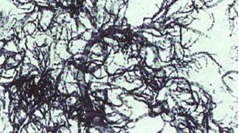

 Cryptogamie, Algologie
23 (1) - Pages 25-37
Cryptogamie, Algologie
23 (1) - Pages 25-37A deep-water species of Dudresnaya, D. multiramosa Afonso-Carrillo, Sansón et Reyes sp. nov., is described from the Canary Islands. Gametophytes are terete and radially branched up to six orders, young branches are annulate but become non-annulate at maturity, hexagonal crystals are lacking in axial cells, rhizoids reach 60 µm in diameter, inner cells of cortical fascicles are tri- to pentachotomously branched, and outer cortical cells are ellipsoid/moniliform. Spermatangia are borne singly or in pairs on terminal or subterminal cortical cells of monoecious gametophytes. Carpogonial and auxiliary-cell filaments lack a thick mucilage coat, vegetative laterals or rhizoids. Generative auxiliary cells are smaller and distinguishable by shape from adjacent cells of the auxiliary-cell filament prior to diploidization. Cystocarps consist of up to 12 rounded gonimolobes and are distinctly cleft around the auxiliary-cell filament. Tetrasporophytes are unknown. The new species is mainly distinguished by the cell shapes and pattern of branching of the cortical fascicles and by the multilobed cystocarps. It differs from ail other Dudresnaya species by its autapomorphic characters. The western Atlantic D. bermudensis Setchell, D. georgiana Searles and D. puertoricensis Searles et Ballantine, the Hawaiian D. littleri Abbott and the eastern Pacific D. colombiana Taylor are postulated to be most closely related to D. multiramosa as these are the only other members to display moniliform cortical fascicles among the seventeen described species of the genus.
Canary Islands, Dudresnaya multiramosa, Dumontiaceae, marine algae, morphology, Rhodophyta, seaweed, taxonomy